


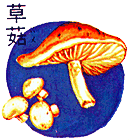
Some plants and fungi are endangered and/or protected. Make absolutely certain before you harvest any green plant, fungus or lichen that it is okay to do so.
Plant seeds can easily be grown outside of soil so that they can be examined while sprouting. Line a glass jar with a piece of paper towel so that the edge of the towel touches the bottom of the jar. Dampen the towel and put a little water in the bottom of the jar. Put a few beans or corn seeds between the paper and the glass, about halfway down. The paper should hold them in place. Keep the paper moist but not soggy. Place the jar in a sunny location. In a few days the seeds will sprout, first  sending roots downward, followed by stems above. The beans are dicots, meaning they will sprout with two little seed leaves. The corn is a monocot and sprouts with a single blade. Early in their growth, the seedlings use the food stored in the seed. Eventually, they will need to be planted in soil so that they will have minerals for growth.
sending roots downward, followed by stems above. The beans are dicots, meaning they will sprout with two little seed leaves. The corn is a monocot and sprouts with a single blade. Early in their growth, the seedlings use the food stored in the seed. Eventually, they will need to be planted in soil so that they will have minerals for growth.
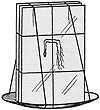 You can also do this by layering a piece of paper towel between two small pieces of glass. The towel, which is the same size as the glass, is placed on the first piece of glass. It is then dampened and a few small seeds, such as radish seeds, are placed on it. The second sheet is placed on top and the whole thing is secured with string or rubber bands. It is then placed in a shallow pan and held upright by lashing it with pieces of string. Add a little water to the pan, which will keep the paper towel moist. Eventually the seeds will sprout. If the glass is turned a quarter of the way around after the roots are somewhat established, they will bend to grow towards the water. No matter how you turn the glass, the roots will grow downward.
You can also do this by layering a piece of paper towel between two small pieces of glass. The towel, which is the same size as the glass, is placed on the first piece of glass. It is then dampened and a few small seeds, such as radish seeds, are placed on it. The second sheet is placed on top and the whole thing is secured with string or rubber bands. It is then placed in a shallow pan and held upright by lashing it with pieces of string. Add a little water to the pan, which will keep the paper towel moist. Eventually the seeds will sprout. If the glass is turned a quarter of the way around after the roots are somewhat established, they will bend to grow towards the water. No matter how you turn the glass, the roots will grow downward.
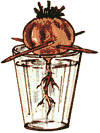 Many fruit and vegetable seeds, such as orange, grapefruit, apple, lemon or tomato seeds, can easily be sprouted indoors. Plant them in small pots filled with good garden soil. The seeds should be planted about twice as deep as they are wide. They will sprout at different rates depending on the seed, the citrus fruits usually taking the longest. Avocado pits can be sprouted by sticking toothpicks in the side to form a support that will hold it in the top of a glass or jar filled with water. The wide end of the seed should be just submerged in the water - this is the end where the root will emerge. Keep the glass filled with water and before too long you will have a plant that can be transplanted to a flowerpot. Cuttings from potatoes and sweet potatoes can be grown in a similar way. Make sure your cutting has at least one "eye", which is where the potato vine will grow. The eye needs to be out of the water. Carrot tops will also grow this way if the root end is kept submerged. All of these plants need to be transplanted to soil eventually, as water alone will not supply nutrients for the plant to continue to grow.
Many fruit and vegetable seeds, such as orange, grapefruit, apple, lemon or tomato seeds, can easily be sprouted indoors. Plant them in small pots filled with good garden soil. The seeds should be planted about twice as deep as they are wide. They will sprout at different rates depending on the seed, the citrus fruits usually taking the longest. Avocado pits can be sprouted by sticking toothpicks in the side to form a support that will hold it in the top of a glass or jar filled with water. The wide end of the seed should be just submerged in the water - this is the end where the root will emerge. Keep the glass filled with water and before too long you will have a plant that can be transplanted to a flowerpot. Cuttings from potatoes and sweet potatoes can be grown in a similar way. Make sure your cutting has at least one "eye", which is where the potato vine will grow. The eye needs to be out of the water. Carrot tops will also grow this way if the root end is kept submerged. All of these plants need to be transplanted to soil eventually, as water alone will not supply nutrients for the plant to continue to grow.
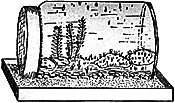 Mosses can be grown in terrariums fairly easily. Collect moss from an area where it is okay to do so and transport in plastic sandwich bags. Sprinkle with water and seal the bag if you won't be setting up the terrarium right away. Use a large, clean glass jar with a tight fitting lid. Lay it on its side in a shallow box or on a stand so that it will not roll. Place sand and pebbles about ½ inch thick in the bottom of the jar. On top of this place some of the soil from the same place where the moss will be collected, or mix a soil of charcoal, light gravel, leaf mold and garden soil. The soil should be level with the opening of the jar. A little sulfur scattered on the soil will help to prevent mold from growing. Plant the moss by pressing it into the soil. Water the terrarium, screw the cover on, and place it in a shady place. If it seems too wet, leave the lid off for a few hours to allow some of the water vapor to escape. Eventually you will get the balance of water just right, and the moss should thrive. The terrarium should sustain itself for several weeks or months without needing additional water if the lid is kept tightly on. If conditions are just right, the moss may eventually send up little stalks. Some of these stalks form spores that will fall to the soil and germinate into new plants.
Mosses can be grown in terrariums fairly easily. Collect moss from an area where it is okay to do so and transport in plastic sandwich bags. Sprinkle with water and seal the bag if you won't be setting up the terrarium right away. Use a large, clean glass jar with a tight fitting lid. Lay it on its side in a shallow box or on a stand so that it will not roll. Place sand and pebbles about ½ inch thick in the bottom of the jar. On top of this place some of the soil from the same place where the moss will be collected, or mix a soil of charcoal, light gravel, leaf mold and garden soil. The soil should be level with the opening of the jar. A little sulfur scattered on the soil will help to prevent mold from growing. Plant the moss by pressing it into the soil. Water the terrarium, screw the cover on, and place it in a shady place. If it seems too wet, leave the lid off for a few hours to allow some of the water vapor to escape. Eventually you will get the balance of water just right, and the moss should thrive. The terrarium should sustain itself for several weeks or months without needing additional water if the lid is kept tightly on. If conditions are just right, the moss may eventually send up little stalks. Some of these stalks form spores that will fall to the soil and germinate into new plants.
Lichens grow on rocks, in poor soil, and other places where many plants cannot grow. They are a symbiotic combination of two organisms: a fungus, which anchors the plant and collects water, and an algae, which is a green plant that provides food. They often grow on rocks and are part of the erosion process, slowly breaking the rock down into soil. Lichens can be collected for terrariums. Keep in mind that some species of lichen are endangered and protected by law, so be sure it is okay to harvest a particular species from wherever you have found it. Once collected, place in a terrarium with a soil of 1 part loam, 1 part sand, and 2 parts humus. Add a few twigs and small rocks. Water, but don't over water or mold may form. Seal with a tight fitting lid and place in a sunny but cool location. Usually, even dry lichens that appear dead will soon thrive in the humid terrarium.
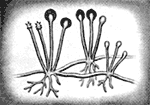 Mold is a fungus and relies on whatever it is growing on for nutrients. It grows from spores, which float through the air and begin to grow when they land on a good source of food in a warm, damp place. You easily grow certain varieties for study on a piece of bread. Sprinkle a piece of bread with water, and let it stand for about an hour. Place it in a jar and screw the lid on tightly. Put the jar in a warm, dark place. In two or three days the bread should be covered with white cottony material and small black dots. This is common bread mold. Any other colors seen are from other varieties of mold. If you look at it under a magnifying glass or low power microscope, you will see that the white material is actually threadlike. This is the mycelium, and is the same structure as the "root" of a mushroom (not a true root). Some of the mycelium branches upward, ending in sporangia, or spore cases, containing many spores that will eventually burst free and float away to form new plants. Discard the bread after examining.
Yeast is also a fungus, and gives off carbon dioxide as it grows. This carbon dioxide is what gives lightness to yeast breads and bubbles (and alcohol) to beer. If you put a little baking yeast into a cup of sugar water and let stand in a warm place for a few minutes, you should be able to see the yeast plants budding to from new plants.
Mold is a fungus and relies on whatever it is growing on for nutrients. It grows from spores, which float through the air and begin to grow when they land on a good source of food in a warm, damp place. You easily grow certain varieties for study on a piece of bread. Sprinkle a piece of bread with water, and let it stand for about an hour. Place it in a jar and screw the lid on tightly. Put the jar in a warm, dark place. In two or three days the bread should be covered with white cottony material and small black dots. This is common bread mold. Any other colors seen are from other varieties of mold. If you look at it under a magnifying glass or low power microscope, you will see that the white material is actually threadlike. This is the mycelium, and is the same structure as the "root" of a mushroom (not a true root). Some of the mycelium branches upward, ending in sporangia, or spore cases, containing many spores that will eventually burst free and float away to form new plants. Discard the bread after examining.
Yeast is also a fungus, and gives off carbon dioxide as it grows. This carbon dioxide is what gives lightness to yeast breads and bubbles (and alcohol) to beer. If you put a little baking yeast into a cup of sugar water and let stand in a warm place for a few minutes, you should be able to see the yeast plants budding to from new plants.
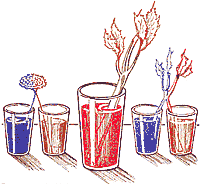 Water normally enters a plant through its roots. It is carried upwards to all parts of the plant by means by capillary action. You can make the tubes that carry water through a plant easier to see with a class of water that has been dyed with food coloring. Set a whole carrot (without its green top) in a glass of water dyes with food coloring - red works the best. Let the carrot sit overnight. Remove it from the glass, and slice off a section from the top. Slice the bottom part lengthwise and you can easily see where the water has flowed. The tubes that carry the water, by the way, are called xylem.
Water normally enters a plant through its roots. It is carried upwards to all parts of the plant by means by capillary action. You can make the tubes that carry water through a plant easier to see with a class of water that has been dyed with food coloring. Set a whole carrot (without its green top) in a glass of water dyes with food coloring - red works the best. Let the carrot sit overnight. Remove it from the glass, and slice off a section from the top. Slice the bottom part lengthwise and you can easily see where the water has flowed. The tubes that carry the water, by the way, are called xylem.
This is much more dramatic with a celery stalk. Place the stalk (with leaves) in the dyed water for three hours or so. The water will be carried up through the stalk and out to the leaves, which will be dyed. If another stalk is partly split in half from the bottom, and each half is placed in a different color of water (red and blue, perhaps), then each half will be colored a different shade. The same thing can be done with a white carnation.
Green plants are green because of chlorophyll, which is the chemical responsible for photosynthesis of the plant's food. During the daylight, the plant takes in carbon dioxide, water, and minerals from the ground and air. The chlorophyll, housed in individual cells within tiny bodies called chloroplasts, enables the plant to make sugar (glucose) with the raw materials it takes in, using sunlight as energy. The byproduct is oxygen, which is expelled through tiny openings called stomata, located in the bottoms of the leaves. You can see this oxygen bubbling off water plants in an aquarium. The glucose is stored in the leaves as starch.
If a plant, or part of a plant, is grown totally without sunlight, chlorophyll will not develop. Cover half of a leaf (still attached to the plant) with black paper (geraniums work well for this). Put the plant in sunlight for 48 hours. Remove the black paper and one half of the leaf should be yellowish. Chlorophyll will break down if it does not receive sunlight for an extended period of time. The base color of many leaves is yellow, which is why some leaves turn yellow in the autumn; the other fall colors are due to chemical changes within the leaves. Remove the leaf from the plant and soak it in warm alcohol until the chlorophyll has been removed from it. If the leaf is now dipped in iodine solution, the part that has received sunlight will turn blue, as iodine turns blue in the presence of starch.

Tie several different colored flowers together at the stems. Place a little ammonia in the bottom of a large jar. Suspend the flowers from the top of the jar either by passing the string through a plastic lid that fits the jar or by attaching a strip of wood, wire, etc. across the mouth of the jar that the flowers can be hung from and sealing with plastic wrap. The flowers should not touch the ammonia. In a few minutes, the colors will fade from some of the flowers, especially any reds, purples, or pinks (not so much with white or yellow). The petals of some of the flowers will appear greenish due to the chlorophyll within.
Onward to more plant lore!
This article was printed from the Bizarre Labs website at bizarrelabs.com